key VOLVO V60 2018 Owner´s Manual
[x] Cancel search | Manufacturer: VOLVO, Model Year: 2018, Model line: V60, Model: VOLVO V60 2018Pages: 406, PDF Size: 9.59 MB
Page 5 of 406
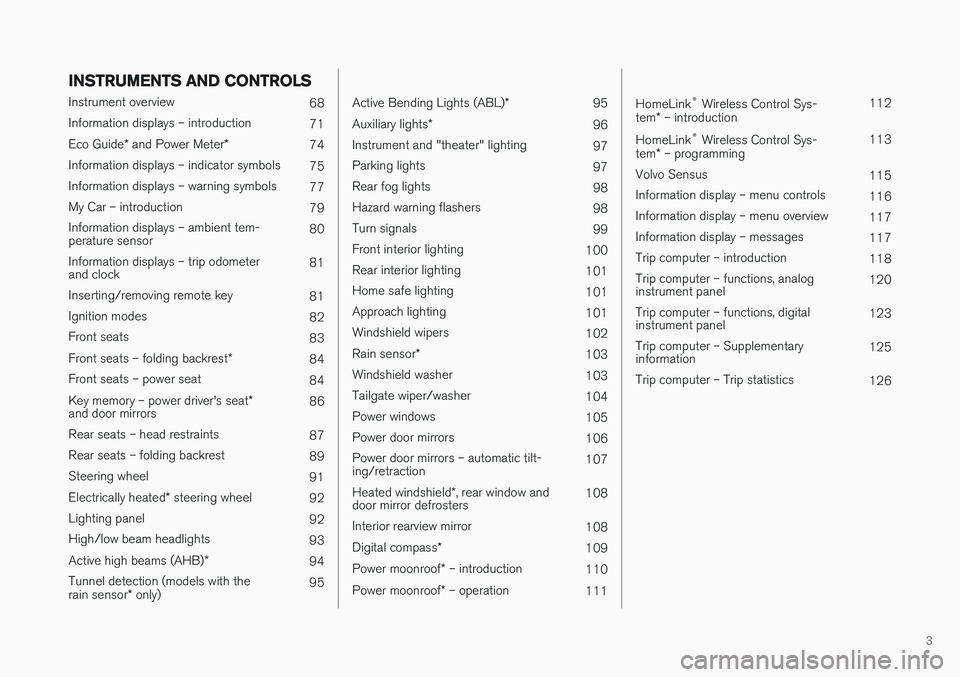
3
INSTRUMENTS AND CONTROLS
Instrument overview 68
Information displays – introduction 71
Eco Guide * and Power Meter *
74
Information displays – indicator symbols 75
Information displays – warning symbols 77
My Car – introduction 79
Information displays – ambient tem- perature sensor 80
Information displays – trip odometerand clock 81
Inserting/removing remote key 81
Ignition modes 82
Front seats 83
Front seats – folding backrest *
84
Front seats – power seat 84
Key memory – power driver's seat *
and door mirrors 86
Rear seats – head restraints 87
Rear seats – folding backrest 89
Steering wheel 91
Electrically heated * steering wheel
92
Lighting panel 92
High/low beam headlights 93
Active high beams (AHB) *
94
Tunnel detection (models with the rain sensor * only) 95
Active Bending Lights (ABL)
*
95
Auxiliary lights *
96
Instrument and "theater" lighting 97
Parking lights 97
Rear fog lights 98
Hazard warning flashers 98
Turn signals 99
Front interior lighting 100
Rear interior lighting 101
Home safe lighting 101
Approach lighting 101
Windshield wipers 102
Rain sensor *
103
Windshield washer 103
Tailgate wiper/washer 104
Power windows 105
Power door mirrors 106
Power door mirrors – automatic tilt- ing/retraction 107
Heated windshield *, rear window and
door mirror defrosters 108
Interior rearview mirror 108
Digital compass *
109
Power moonroof * – introduction
110
Power moonroof * – operation
111
HomeLink®
Wireless Control Sys-
tem * – introduction 112
HomeLink ®
Wireless Control Sys-
tem * – programming 113
Volvo Sensus 115
Information display – menu controls 116
Information display – menu overview 117
Information display – messages 117
Trip computer – introduction 118
Trip computer – functions, analog instrument panel 120
Trip computer – functions, digitalinstrument panel 123
Trip computer – Supplementaryinformation 125
Trip computer – Trip statistics 126
Page 6 of 406
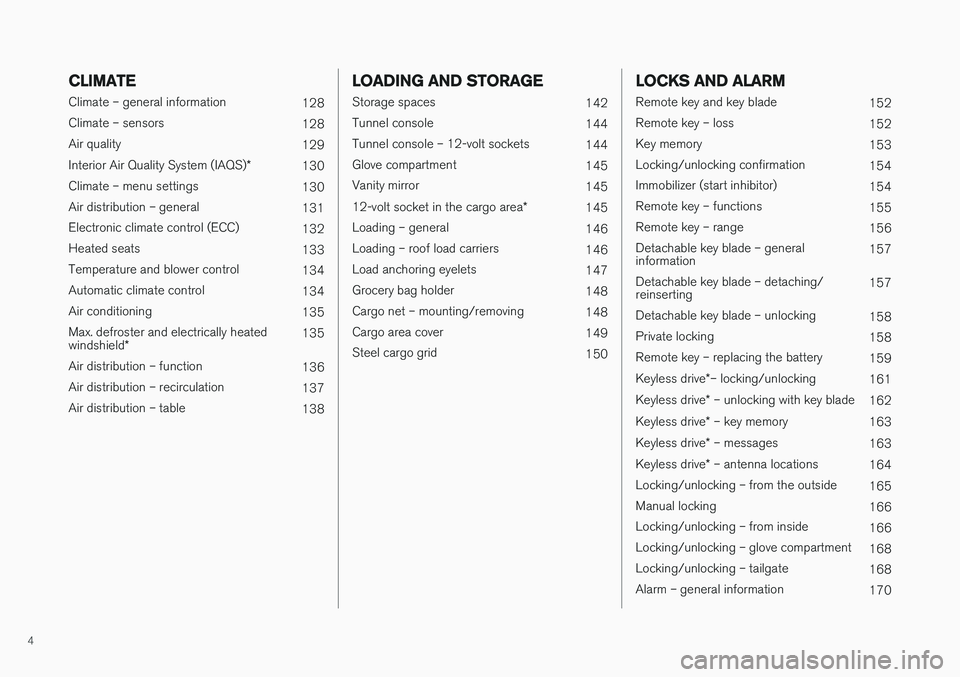
4
CLIMATE
Climate – general information128
Climate – sensors 128
Air quality 129
Interior Air Quality System (IAQS) *
130
Climate – menu settings 130
Air distribution – general 131
Electronic climate control (ECC) 132
Heated seats 133
Temperature and blower control 134
Automatic climate control 134
Air conditioning 135
Max. defroster and electrically heated windshield * 135
Air distribution – function 136
Air distribution – recirculation 137
Air distribution – table 138
LOADING AND STORAGE
Storage spaces142
Tunnel console 144
Tunnel console – 12-volt sockets 144
Glove compartment 145
Vanity mirror 145
12-volt socket in the cargo area *
145
Loading – general 146
Loading – roof load carriers 146
Load anchoring eyelets 147
Grocery bag holder 148
Cargo net – mounting/removing 148
Cargo area cover 149
Steel cargo grid 150
LOCKS AND ALARM
Remote key and key blade152
Remote key – loss 152
Key memory 153
Locking/unlocking confirmation 154
Immobilizer (start inhibitor) 154
Remote key – functions 155
Remote key – range 156
Detachable key blade – general information 157
Detachable key blade – detaching/reinserting 157
Detachable key blade – unlocking 158
Private locking 158
Remote key – replacing the battery 159
Keyless drive *– locking/unlocking
161
Keyless drive * – unlocking with key blade
162
Keyless drive * – key memory
163
Keyless drive * – messages
163
Keyless drive * – antenna locations
164
Locking/unlocking – from the outside 165
Manual locking 166
Locking/unlocking – from inside 166
Locking/unlocking – glove compartment 168
Locking/unlocking – tailgate 168
Alarm – general information 170
Page 14 of 406
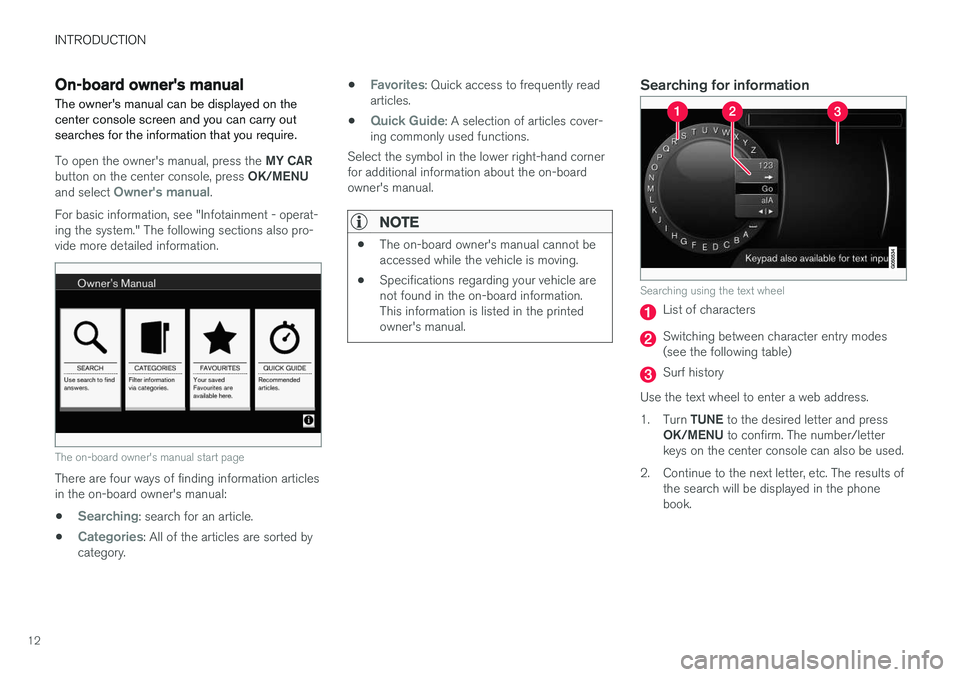
INTRODUCTION
12
On-board owner's manual The owner's manual can be displayed on the center console screen and you can carry outsearches for the information that you require.
To open the owner's manual, press the MY CAR
button on the center console, press OK/MENU
and select
Owner's manual.
For basic information, see "Infotainment - operat- ing the system." The following sections also pro-vide more detailed information.
The on-board owner's manual start page
There are four ways of finding information articles in the on-board owner's manual:
•
Searching: search for an article.
•
Categories: All of the articles are sorted by
category. •
Favorites: Quick access to frequently read
articles.
•
Quick Guide: A selection of articles cover-
ing commonly used functions.
Select the symbol in the lower right-hand corner for additional information about the on-boardowner's manual.
NOTE
• The on-board owner's manual cannot be accessed while the vehicle is moving.
• Specifications regarding your vehicle arenot found in the on-board information.This information is listed in the printedowner's manual.
Searching for information
Searching using the text wheel
List of characters
Switching between character entry modes (see the following table)
Surf history
Use the text wheel to enter a web address. 1. Turn TUNE to the desired letter and press
OK/MENU to confirm. The number/letter
keys on the center console can also be used.
2. Continue to the next letter, etc. The results of the search will be displayed in the phone book.
Page 15 of 406
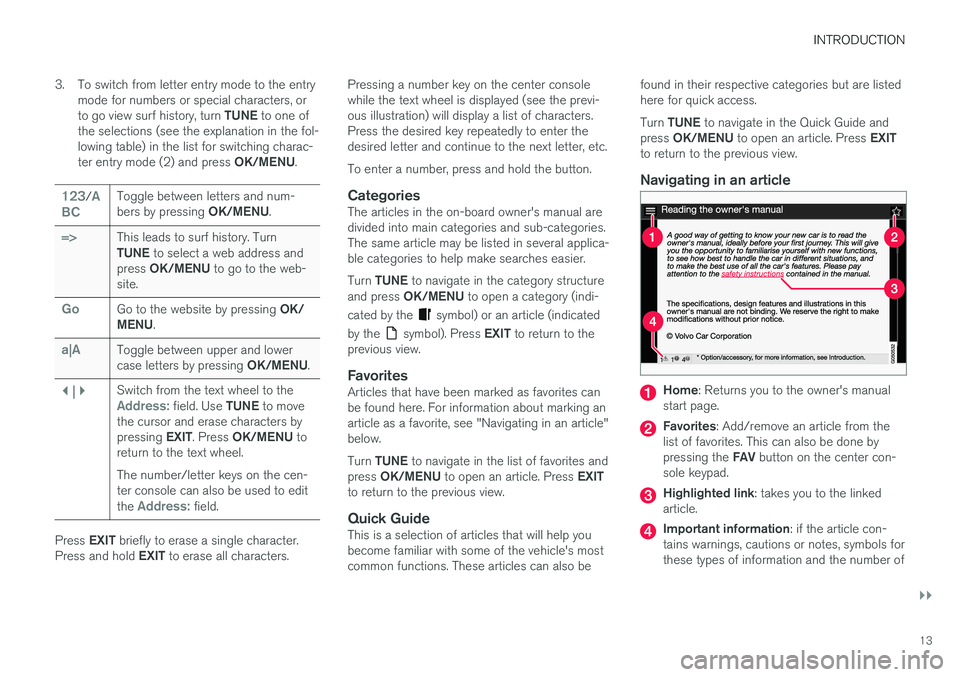
INTRODUCTION
}}
13
3. To switch from letter entry mode to the entry
mode for numbers or special characters, or to go view surf history, turn TUNE to one of
the selections (see the explanation in the fol- lowing table) in the list for switching charac- ter entry mode (2) and press OK/MENU.
123/A
BCToggle between letters and num- bers by pressing OK/MENU.
=>This leads to surf history. Turn TUNE to select a web address and
press OK/MENU to go to the web-
site.
GoGo to the website by pressing OK/
MENU .
a|AToggle between upper and lower case letters by pressing OK/MENU.
| | }Switch from the text wheel to theAddress: field. Use TUNE to move
the cursor and erase characters by pressing EXIT. Press OK/MENU to
return to the text wheel. The number/letter keys on the cen- ter console can also be used to edit the
Address: field.
Press EXIT briefly to erase a single character.
Press and hold EXIT to erase all characters. Pressing a number key on the center console while the text wheel is displayed (see the previ-ous illustration) will display a list of characters.Press the desired key repeatedly to enter thedesired letter and continue to the next letter, etc. To enter a number, press and hold the button.
CategoriesThe articles in the on-board owner's manual are divided into main categories and sub-categories.The same article may be listed in several applica-ble categories to help make searches easier. Turn
TUNE to navigate in the category structure
and press OK/MENU to open a category (indi-
cated by the
symbol) or an article (indicated
by the
symbol). Press EXIT to return to the
previous view.
FavoritesArticles that have been marked as favorites can be found here. For information about marking anarticle as a favorite, see "Navigating in an article"below. Turn TUNE to navigate in the list of favorites and
press OK/MENU to open an article. Press EXIT
to return to the previous view.
Quick GuideThis is a selection of articles that will help you become familiar with some of the vehicle's mostcommon functions. These articles can also be found in their respective categories but are listedhere for quick access. Turn
TUNE to navigate in the Quick Guide and
press OK/MENU to open an article. Press EXIT
to return to the previous view.
Navigating in an article
Home : Returns you to the owner's manual
start page.
Favorites : Add/remove an article from the
list of favorites. This can also be done by pressing the FAV button on the center con-
sole keypad.
Highlighted link : takes you to the linked
article.
Important information : if the article con-
tains warnings, cautions or notes, symbols for these types of information and the number of
Page 36 of 406
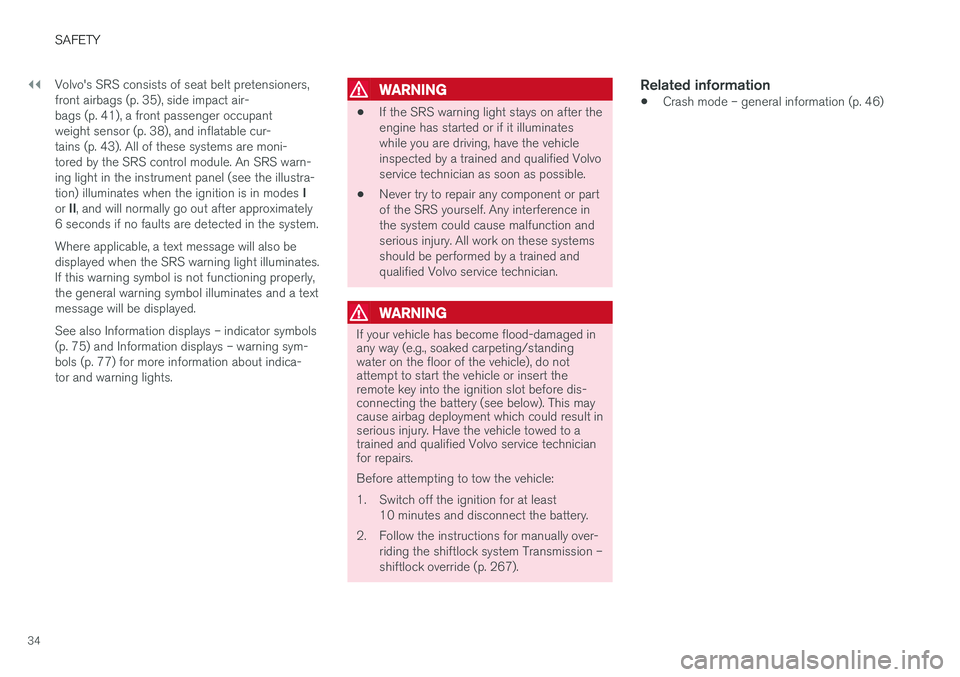
||
SAFETY
34Volvo's SRS consists of seat belt pretensioners, front airbags (p. 35), side impact air-bags (p. 41), a front passenger occupantweight sensor (p. 38), and inflatable cur-tains (p. 43). All of these systems are moni-tored by the SRS control module. An SRS warn-ing light in the instrument panel (see the illustra- tion) illuminates when the ignition is in modes
I
or II, and will normally go out after approximately
6 seconds if no faults are detected in the system. Where applicable, a text message will also be displayed when the SRS warning light illuminates.If this warning symbol is not functioning properly,the general warning symbol illuminates and a textmessage will be displayed. See also Information displays – indicator symbols (p. 75) and Information displays – warning sym-bols (p. 77) for more information about indica-tor and warning lights.
WARNING
• If the SRS warning light stays on after the engine has started or if it illuminateswhile you are driving, have the vehicleinspected by a trained and qualified Volvoservice technician as soon as possible.
• Never try to repair any component or partof the SRS yourself. Any interference inthe system could cause malfunction andserious injury. All work on these systemsshould be performed by a trained andqualified Volvo service technician.
WARNING
If your vehicle has become flood-damaged in any way (e.g., soaked carpeting/standingwater on the floor of the vehicle), do notattempt to start the vehicle or insert theremote key into the ignition slot before dis-connecting the battery (see below). This maycause airbag deployment which could result inserious injury. Have the vehicle towed to atrained and qualified Volvo service technicianfor repairs. Before attempting to tow the vehicle:
1. Switch off the ignition for at least
10 minutes and disconnect the battery.
2. Follow the instructions for manually over- riding the shiftlock system Transmission – shiftlock override (p. 267).
Related information
•Crash mode – general information (p. 46)
Page 49 of 406
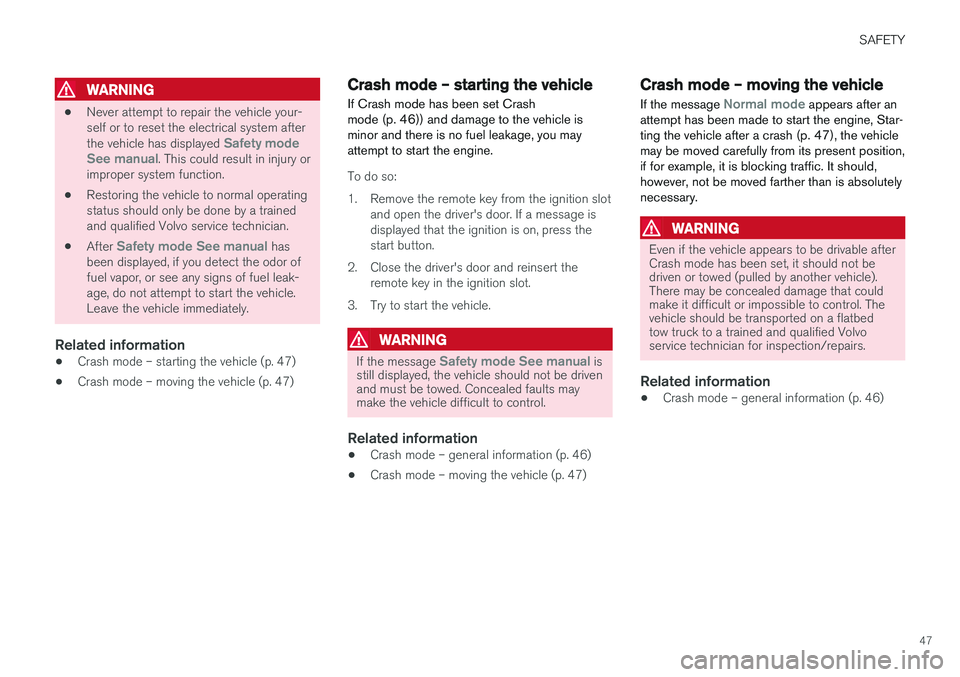
SAFETY
47
WARNING
•Never attempt to repair the vehicle your- self or to reset the electrical system after the vehicle has displayed
Safety mode
See manual. This could result in injury or
improper system function.
• Restoring the vehicle to normal operating status should only be done by a trainedand qualified Volvo service technician.
• After
Safety mode See manual has
been displayed, if you detect the odor of fuel vapor, or see any signs of fuel leak-age, do not attempt to start the vehicle.Leave the vehicle immediately.
Related information
• Crash mode – starting the vehicle (p. 47)
• Crash mode – moving the vehicle (p. 47)
Crash mode – starting the vehicle
If Crash mode has been set Crash mode (p. 46)) and damage to the vehicle isminor and there is no fuel leakage, you mayattempt to start the engine.
To do so:
1. Remove the remote key from the ignition slot and open the driver's door. If a message is displayed that the ignition is on, press thestart button.
2. Close the driver's door and reinsert the remote key in the ignition slot.
3. Try to start the vehicle.
WARNING
If the message Safety mode See manual is
still displayed, the vehicle should not be driven and must be towed. Concealed faults maymake the vehicle difficult to control.
Related information
• Crash mode – general information (p. 46)
• Crash mode – moving the vehicle (p. 47)
Crash mode – moving the vehicle
If the message
Normal mode appears after an
attempt has been made to start the engine, Star- ting the vehicle after a crash (p. 47), the vehiclemay be moved carefully from its present position,if for example, it is blocking traffic. It should,however, not be moved farther than is absolutelynecessary.
WARNING
Even if the vehicle appears to be drivable after Crash mode has been set, it should not bedriven or towed (pulled by another vehicle).There may be concealed damage that couldmake it difficult or impossible to control. Thevehicle should be transported on a flatbedtow truck to a trained and qualified Volvoservice technician for inspection/repairs.
Related information
• Crash mode – general information (p. 46)
Page 67 of 406
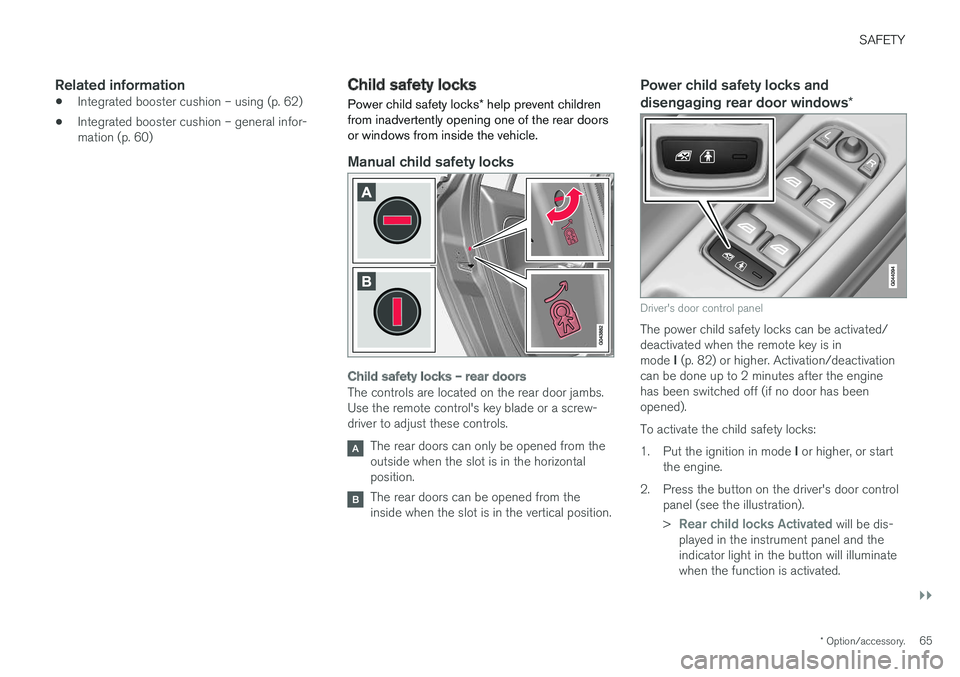
SAFETY
}}
* Option/accessory.65
Related information
•Integrated booster cushion – using (p. 62)
• Integrated booster cushion – general infor- mation (p. 60)
Child safety locks
Power child safety locks * help prevent children
from inadvertently opening one of the rear doors or windows from inside the vehicle.
Manual child safety locks
Child safety locks – rear doors
The controls are located on the rear door jambs. Use the remote control's key blade or a screw-driver to adjust these controls.
The rear doors can only be opened from the outside when the slot is in the horizontalposition.
The rear doors can be opened from the inside when the slot is in the vertical position.
Power child safety locks and disengaging rear door windows *
Driver's door control panel
The power child safety locks can be activated/ deactivated when the remote key is in mode I (p. 82) or higher. Activation/deactivation
can be done up to 2 minutes after the engine has been switched off (if no door has beenopened). To activate the child safety locks:1. Put the ignition in mode I or higher, or start
the engine.
2. Press the button on the driver's door control panel (see the illustration). >
Rear child locks Activated will be dis-
played in the instrument panel and the indicator light in the button will illuminatewhen the function is activated.
Page 68 of 406
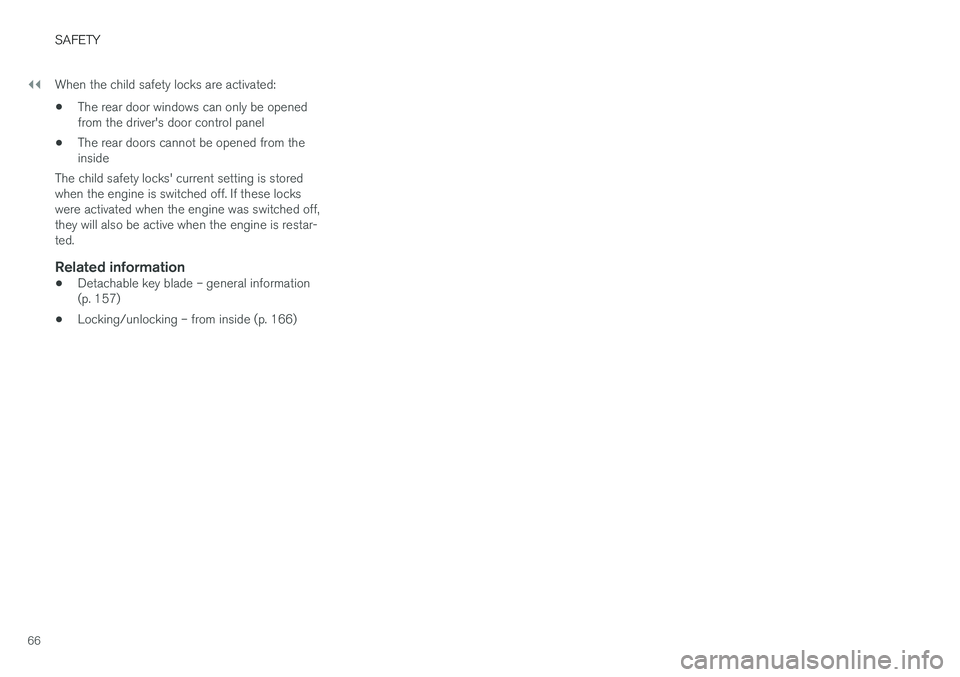
||
SAFETY
66When the child safety locks are activated: •
The rear door windows can only be opened from the driver's door control panel
• The rear doors cannot be opened from theinside
The child safety locks' current setting is storedwhen the engine is switched off. If these lockswere activated when the engine was switched off,they will also be active when the engine is restar-ted.
Related information
• Detachable key blade – general information(p. 157)
• Locking/unlocking – from inside (p. 166)
Page 81 of 406

INSTRUMENTS AND CONTROLS
}}
79
Reminder – doors not closed
If one of the doors is not closed properly, the
information or warning symbol illuminates
(depending on the vehicle's speed), a graphic will be displayed in instrument panel and an explana- tory text message 3
will also be displayed in the
instrument panel. Stop the vehicle in a safe place as soon as possible and close the door.
If the vehicle is driven at a speed lowerthan approximately 5 mph (7 km/h),the information symbol illuminates.
If the vehicle is driven at a speed higher than approximately 5 mph(7 km/h), the warning symbol illumi-
nates.
If the hood is not closed properly, the warning
symbol illuminates, a graphic will be displayed in instrument panel and an explanatory text mes- sage 3
will also be displayed in the instrument
panel. Stop the vehicle in a safe place as soon as possible and close the hood. If the tailgate is not closed properly, the infor-
mation symbol illuminates and a graphic will be
displayed in instrument panel. Stop the vehicle in a safe place as soon as possible and close thetailgate.
Related information
• Information displays – introduction (p. 71)
• Information displays – indicator symbols(p. 75)
• Engine compartment – coolant (p. 342)
My Car – introduction
The MY CAR menu system provides access to menus for operating many of the vehicle's func-tions, such as setting the clock, door mirrors,lock and alarm settings, etc.
Some of the features or functions are standard; others are optional and vary according to model/market.
OperationUse the buttons on the center console or thesteering wheel keypad to navigate in the menus.
3 Text message applies only to models with the optional digital instrument panel
Page 82 of 406
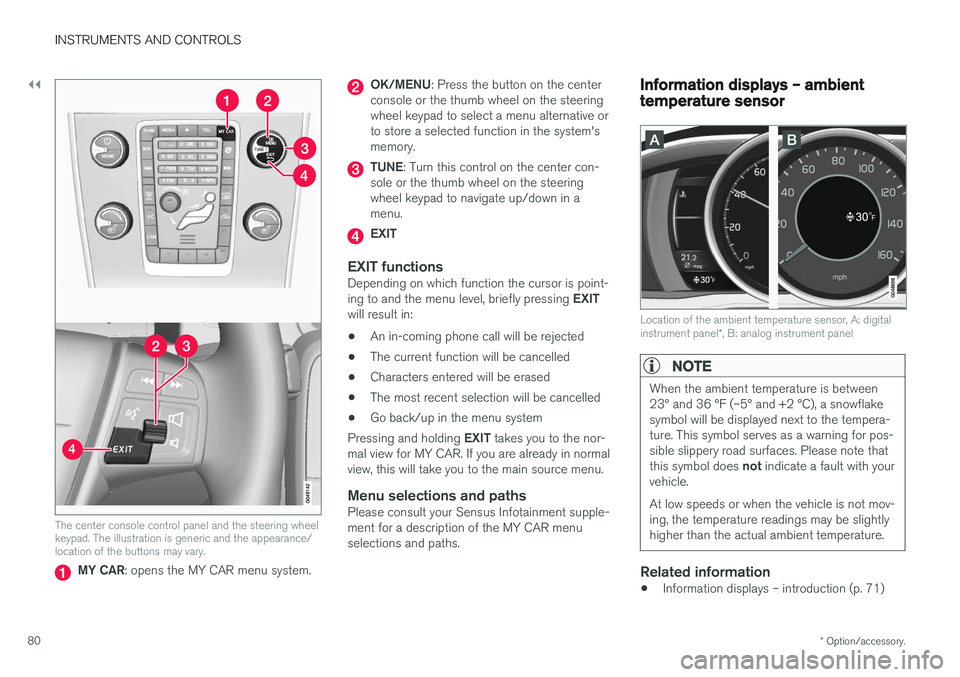
||
INSTRUMENTS AND CONTROLS
* Option/accessory.
80
The center console control panel and the steering wheel keypad. The illustration is generic and the appearance/location of the buttons may vary.
MY CAR : opens the MY CAR menu system.
OK/MENU : Press the button on the center
console or the thumb wheel on the steering wheel keypad to select a menu alternative orto store a selected function in the system'smemory.
TUNE : Turn this control on the center con-
sole or the thumb wheel on the steering wheel keypad to navigate up/down in amenu.
EXIT
EXIT functionsDepending on which function the cursor is point- ing to and the menu level, briefly pressing EXIT
will result in:
• An in-coming phone call will be rejected
• The current function will be cancelled
• Characters entered will be erased
• The most recent selection will be cancelled
• Go back/up in the menu system
Pressing and holding EXIT takes you to the nor-
mal view for MY CAR. If you are already in normal view, this will take you to the main source menu.
Menu selections and pathsPlease consult your Sensus Infotainment supple-ment for a description of the MY CAR menuselections and paths.
Information displays – ambient temperature sensor
Location of the ambient temperature sensor, A: digital instrument panel *, B: analog instrument panel
NOTE
When the ambient temperature is between 23° and 36 °F (–5° and +2 °C), a snowflakesymbol will be displayed next to the tempera-ture. This symbol serves as a warning for pos-sible slippery road surfaces. Please note that this symbol does not indicate a fault with your
vehicle. At low speeds or when the vehicle is not mov- ing, the temperature readings may be slightlyhigher than the actual ambient temperature.
Related information
• Information displays – introduction (p. 71)